Machine Recycling Discussion and Moderated Newsgroup > Full Machines
> Incomplete Machines
> South
> New
> Calcium chloride (CACL2) E509 food grade 4 lbs
Calcium chloride (CACL2) E509 food grade 4 lbs
Calcium chloride, CaCl2, is a common salt and the compound of Calcium and Chlorine. It behaves as a typical ionic halide, and is solid at room temperature. It has several common applications such as brine for refrigeration plants, ice and dust control on roads, and in concrete. The anhydrous salt is also widely used as a desiccant, where it will adsorb so much water that it will eventually dissolve in its own crystal lattice water. It can be produced directly from limestone, but large amounts are also produced as a by-product of the Solvay process. Because of its hygroscopickelp into a solid.
nature, the anhydrous form must be kept in tightly-sealed containers. It is used to turn
Because the anhydrous salt is strongly hygroscopic, air or other gases may be channeled through a column of calcium chloride to remove moisture. In particular, calcium chloride is usually used to pack drying tubes to exclude atmospheric moisture from a reaction set-up while allowing gases to escape. It cannot, however, be used to dry alkaline gases such as ammonia because it will form addition products. It is used to dry kelp, which is then used to produce soda ash. It can also be added to liquids to remove suspended or dissolved water. The dissolving process is highly exothermic and rapidly produces temperatures of around 60 C (140 F). In this capacity, it is known as a drying agent or desiccant. It is converted to a brine as it adsorbs the water or water vapor from the substance to be dried:
CaCl2 + 2 H2O CaCl2 2H2O
Aided by the intense heat evolved during its dissolution, calcium chloride is also used as an ice-melting compound. Unlike the more-common sodium chloride (rock salt or halite), it is relatively harmless to plants and soil; however, recent observations in Washington state suggest it may be particularly harsh on roadside evergreen trees.[2] It is also more effective at lower temperatures than sodium chloride. When distributed for this use, it usually takes the form of small white balls a few millimetres in diameter, called prills (see picture at top of page).
Used for its hygroscopic property, it can be applied to keep a liquid layer on the surface of the roadway, which holds dust down.[3] It is used in concrete mixes to help speed up the initial setting, but chloride ion leads to corrosion of steel rebar, so it should not be used in reinforced concrete.[4] The anhydrous form of calcium chloride may also be used for this purpose and can provide a measure of the moisture in concrete.[5]
Aqueous calcium chloride (in solution with water) lowers the freezing point as low as 52 C ( 62 F), making it ideal for filling agricultural implement tires as a liquid ballast, aiding traction in cold climates.[6]
Calcium Chloride is also commonly used as an additive in swimming pool water as it increases the "Calcium Hardness" value for the water. Low Calcium Hardness values in pool water cause pool water to be corrosive on equipment, pumps and metal fittings.
Other industrial applications include use as an additive in plastics, as a drainage aid for wastewater treatment, as an additive in fire extinguishers, as an additive in control scaffolding in blast furnaces, and as a thinner in fabric softener.
North American consumption in 2002 was 1,687,000 tons (3.7 billion pounds).[7] A Dow Chemical Company manufacturing facility in Michigan, houses about 35% of the total U.S. production capacity for calcium chloride.[8]
As an ingredient, it is listed as a permitted food additive in the European Union for use as a sequestrant and firming agent with the E number E509, and considered as generally recognized as safe (GRAS) by the U.S. Food and Drug Administration.[9] The average intake of calcium chloride as food additives has been estimated to be 160 345 mg/day for individuals.[10] Ingestion of concentrated or pure calcium chloride products may cause gastrointestinal irritation or ulceration.[11] The anhydrous form has been approved by the FDA as a packaging aid to ensure dryness (CPG 7117.02).[12]
Calcium chloride is commonly used as an electrolyte and has an extremely salty taste, as found in sports drinks and other beverages such as Smartwater and Nestle bottled water. It can also be used as a preservative to maintain firmness in canned vegetables or in higher concentrations in pickles to give a salty taste while not increasing the food's sodium content. It is even found in snack foods, including Cadbury Caramilk chocolate bars to retard freezing of the caramel in cold conditions.
It can be used to make a caviar substitute from vegetable or fruit juices[13] or added to processed milk to restore the natural balance between calcium and protein for the purposes of making cheese such as brie and stilton. Calcium chloride's exothermic properties are exploited in many 'self heating' food products where it is activated (mixed) with water to start the heating process, providing a non-explosive, dry fuel that is easily activated.
In brewing beer, calcium chloride is sometimes used to correct mineral deficiencies in the brewing water. It affects flavor and chemical reactions during the brewing process, and it can also affect yeast function during fermentation.
It can also be used in the reef aquarium hobby for adding bio-available calcium in solution for calcium-using animals such as snails, hard tube worms, and corals although the use of calcium hydroxide (kalkwasser mix) or a calcium reactor is the preferred method of adding calcium. However, calcium chloride is the quickest method to increase calcium levels as it dissolves readily in water.

